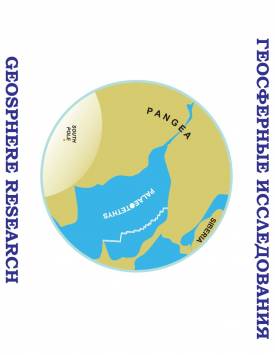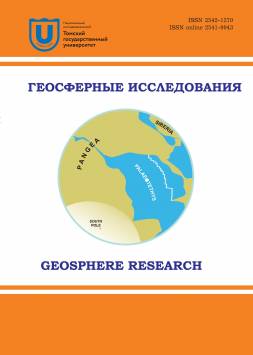Glacier change on the Koryak Highlands, north-east Asia, between 1972 and 2019
The availability of satellite imagery offers the opportunity to view glacier changes for remote and inaccessible regions such as the Koryak Highlands (Northeastern Russia). In this study, multi-annual fluctuations of glacier area for this region were assessed for the period 1972-2019 based on different satellite images. Since study of the glaciers in the 20th century in this region was scarce and contradictory, the character of glacier changes and its relation to climate are poorly understood. There are not enough reliable data in the USSR Glacier Inventory compiled in the end of 1960s for this region, therefore a reassessment is necessary. For this purpose, Corona images offer a valuable opportunity to map margins of the glaciers around the 1970s. The state of glaciers in 2019 was obtained based on Sentinel-2 images. As a result, over the period from 1972 to 2019, the total surface area of glaciers in the Koryak Highlands decreased by almost half: from 85.1 ± 0.9 km2 in 1972 to 38.9 ± 0.8 km2 in 2019. The mean rate of area change was 0.98 km2 yr-1 over the study period. The surface area loss of each glacier for 1972-2019 ranged from 14.3 to 81.4 %. Glaciers with an area of less than 0.2 km2 lost on average 63.7% of their area. Glaciers with an area of 0.2 to 0.5 km2 and from 0.5 to 0.1 km2 lost 58.1 % and 53.9 % of their area, respectively, over the same period. The largest glaciers (more than 1 km2) lost the least area (on average, 46.2 %). Glaciers with eastern, northeastern and southwestern aspects lost respectively 61.8 %, 60.4 % and 63.5 % of their area, while glaciers with northern, northwestern and western aspects lost respectively, 58.5 %, 56.6 % and 57.2 % of their area for 1972 to 2019. The small glaciers, which are few in number of the southern aspect showed the least area loss (on average, 47.4 %). The degree of the glaciers preservation even with significant reduction in area points at more important role of the orographic factor (relief features) compared to climatic one. Glaciers of the Koryak and Chukotka highlands demonstrate approximately the same rate of reduction in percentage for the entire period from 1972/75 to 2019. However, compared to the glaciers of the Sredinny Range on Kamchatka, glaciation in the Koryak and Chukotka Highlands decreased faster. Contribution of the authors: the authors contributed equally to this article. The authors declare no conflicts of interests.
Keywords
Northeastern asia,
Koryak Highlands,
mountain glaciers,
remote sensing,
glacier change,
climate changeAuthors
| Ananicheva Maria D. | Institute of Geography, RAS | maranan@gmail.com |
| Kononov Yury M. | Institute of Geography, RAS | jukon02@mail.ru |
Всего: 2
References
Ананичева М.Д. Современное состояние ледников Корякского нагорья и оценка их эволюции к середине текущего столетия // Лёд и Снег. 2012. № 1 (117). С. 15-23.
Ананичева М.Д., Капустин Г.А., Михайлов А.Ю. Ледники Мейныпильгынского хребта: современное состояние и сценарий эволюции ледниковых систем // Лёд и Снег. 2012. № 2 (118). С. 40-50.
Ананичева М.Д., Карпачевский А.М. Современное состояние ледников Чукотского и Колымского нагорий и прогноз эволюции ледниковых систем Чукотского нагорья // Фундаментальная и прикладная климатология. 2016. Т. 1. С. 64-83.
Ананичева М.Д., Маслаков А.А., Антонов Е.В. Деградация объектов криосферы в районе залива Лаврентия, Восточная Чукотка // Арктика и Антарктика. 2017. № 3. С. 17-29.
Ананичева М.Д., Алейников А.А., Кононов Ю.М. Проверка данных каталога ледников Корякского нагорья по архивным снимкам Corona и сравнение со снимками Sentinel-2 на фоне меняющегося климата // Криосфера Земли. 2023. Т. 27, № 5. С. 2938. DOI: 10.15372/KZ20230503.
Булыгина О.Н., Разуваев В.Н., Коршунова Н.Н., Швец Н.В. Описание массива данных месячных сумм осадков на станциях России. Свидетельство о государственной регистрации базы данных № 2015620394 // Электронный ресурс. 2020a. URL: http://meteo.ru/data/158-totalprecipitation#description-mass-data (дата обращения: 25.11.2022).
Булыгина О.Н., Разуваев В.Н., Трофименко Л.Т., Швец Н.В. Описание массива данных среднемесячной температуры воздуха на станциях России. Свидетельство о государственной регистрации базы данных № 201462 // Электронный ресурс. 20206. URL: http://meteo.ru/data/156-temperature#description-mass-data (дата обращения: 25.11.2022).
Васьковский А.П Современное оледенение Северо-Востока СССР // Материалы по геологии и полезным ископаемым Северо-Востока СССР. 1955. № 9. С. 71-91.
Виноградов О.Н., Коновалова Г.И., Сватков Н.М. Каталог ледников СССР: Корякское нагорье. Т. 20, ч. 1. Л. : Гидрометеоиздат, 1982. 75 с.
Докукин М.Д., Сейнова И.Б., Савернюк Е.А., Черноморец С.С. О наступании ледников в условиях вулканической деятельности вулкана Ключевской (Камчатка) // Лёд и Снег. 2017. № 57 (1). С. 10-24.
Калесник С.В. Очерки гляциологии. М. : Географгиз, 1963. 551 с.
Каталог ледников СССР. М. ; Л. : Гидрометеоиздат, 1965-1982.
Муравьев А.Я., Носенко Г.А. Изменения оледенения северной части Срединного хребта на Камчатке во второй половине ХХ в. // Лёд и Снег. 2013. № 53 (2). С. 5-11.
Муравьев А.Я. Сокращение ледников северной части Срединного хребта на Камчатке в период с 1950 по 2016-2017 гг. // Лёд и Снег. 2020a. № 60 (4). С. 498-512.
Муравьев А.Я. Распределение и морфология современных ледников Камчатки // Лёд и Снег. 2020б. № 60 (3). С. 325-342. Николаев И.Г., Колосов Д.М. Современные ледники в Коряцком хребте // Известия Государственного географического общества. 1939. Т. 71, № 8. С. 1154-1162.
Носенко Г.А., Муравьев А.Я., Никитин С.А. Баланс массы ледников Корякского нагорья Нежданный и Соседний за 19612016 гг. // Лёд и Снег. 2022. № 62(1). С. 5-16.
Сватков Н.М. Современное оледенение хребта Малиновского // Материалы гляциологических исследований. 1965. № 15. С. 111-119.
Седов Р.В. Ледники Чукотки // Материалы гляциологических исследований. 1997. № 82. С. 213-217.
Седов Р.В. Каталог ледников северо-восточной части Корякского нагорья // Материалы гляциологических исследований. 2001. № 91. С. 195-224.
Ananicheva M.D., Krenke A.N., Barry R.G. The Northeast Asia mountain glaciers in the near future by AOGCM scenarios // The Cryosphere. 2010. V. 4. P. 435-445. doi: 10.5194/tc-4-435-2010.
Ananicheva M., Kononov Yu., Belozerov E. Contemporary state of glaciers in Chukotka and Kolyma highlands // Bulletin of Geography Physical Geography Series. 2020. V.19. P. 5-18. doi: 10.2478/bgeo-2020-0006.
Ananicheva M., Aleinikov A. Glaciers of the Koryak Highlands: assessment of the state using satellite images and field studies // Bulletin of geography (Physical Geography Series). 2022. V. 22. P. 45-58. doi: 10.12775/bgeo-2022-0004.
Andreassen L.M., Elvehoy H., Kjollmoen B., Engeset R.V. Haakensen N. Glacier mass balance and length variations in Norway // Annals of Glaciology. 2005. V. 42. P. 317-325. doi: 10.3189/172756405781812826.
Barnett T.P., Adam J.C., Lettenmaier D.P. Potential impacts of a warming climate on water availability in snow-dominated regions // Nature. 2005. V. 438 (7066). P. 303-309. doi: 10.1038/nature04141.
Braithwaite R.J. After six decades of monitoring glacier mass balance we still need data but it should be richer data // Annals of Glaciology. 2009. V. 50 (50). P. 191-197. doi: 10.3189/172756409787769573.
Braithwaite R.J. From Doktor Kurowski's Schneegrenze to our modern glacier equilibrium line altitude (ELA) // The Cryosphere. 2015. V. 9. P. 2135-2148. doi: 10.5194/tc-9-2135-2015.
Bliss A., Hock R., Radic V. Global response of glacier runoff to twenty-first century climate change // Journal of Geophysical Research: Earth Surface. 2014. V. 119 (4). P. 717-730. doi: 10.1002/2013JF002931.
Chinn T., Winkler S., Salinger M.J., Haakensen N. Recent glacier advances in Norway and New Zealand: acomparison of their glaciological land meteorological causes // Geografiska Annaler (Series A, Physical Geography). 2005. V. 87 (1). P. 141-157 doi: 10.1111/j.0435-3676.2005.00249.x.
Copernicus Climate Change Service. ERA5 hourly data on single levels from 1966 to present. URL: https://cds.climate.copernicus.eu/cdsapp#!/dataset/reanalysis-era5-single-levels?tab=overview (Date of accessed: 17.02.2022).
Das S., Sharma M.C., Murari M.K., Nusser M., Schmidt S. Half-a-century (1971-2020) of glacier shrinkage and climatic variability in the Bhaga basin, western Himalaya // Journal of Mountain Science. 2023. V. 20 (2). P. 299-324. doi: 10.1007/s11629-022-7598-9.
Fukumoto S., Sugiyama S., Hata S., Saito J., Shiraiwa T., Mitsudera H. Glacier mass change on the Kamchatka Peninsula, Russia, from 2000 to 2016 // Journal of Glaciology. 2022. V. 69 (274). P. 237-250. doi: 10.1017/jog.2022.50.
Huss M., Bookhagen B., Huggel C., Jacobsen D., Bradley R.S., Clague J.J., Vuille M., Buytaert W., Cayan D.R., Greenwood G., Mark B.G., Milner A.M., Weingartner R., Winder M. Toward mountains without permanent snow and ice // Earth's Future. 2017. V. 5 (5). P. 418-435. doi: 10.1002/2016EF000514.
Huss M., Hock R. Global-scale hydrological response to future glacier mass loss // Nature Climate Change. 2018. V. 8 (2). P. 135140. doi: 10.1038/s41558-017-0049-x.
Kononov Y.M., Ananicheva M.D., Willis 1C. High-resolution reconstruction of Polar Ural glacier mass balance for the last millennium // Annals of Glaciology. 2005. V. 42. P. 163-170. doi: 10.3189/172756405781812709.
Marzeion B., Kaser G., Maussion F., Champollion N. Limited influence of climate change mitigation on short-term glacier mass loss // Nature Climate Change. 2018. V. 8(4). P. 305-308. doi: 10.1038/s41558-018-0093-1.
Munoz-Sabater J., Dutra E., Agusti-Panareda A., Albergel C., Arduini G., Balsamo G., Boussetta S., Choulga M., Harrigan S., Hersbach H., Martens B., Miralles D.G., Piles M., Rodriguez-Fernandez N.J., Zsoter E., Buontempo C., Thepaut J.-N. ERA5-Land: a state-of-the-art global reanalysis dataset for land applications // Earth System Science Data. 2021. V. 13. P. 4349-4383. doi: 10.5194/essd-13-4349-2021.
Musselman K.N., Clark M.P., Liu C., Ikeda K Rasmussen R. Slower snowmelt in a warmer world // Nature Climate Change. 2017. V. 7 (3). P. 214-219. doi: 10.1038/nclimate3225.
Oerlemans J. Quantifying global warming from the retreat of glaciers // Science. 1994. V. 264 (5156). P. 243-245. doi: 10.1126/ science.264.5156.243.
Pepin N.C., Arnone E., Gobiet A., Haslinger K., Kotlarski S., Notarnicola C., Palazzi E., Seibert P., Serafin S., Schoner W., Terzago S., Thornton J.M., Vuille M., Adler C. Climate changes and their elevational patterns in the mountains of the world // Reviews of Geophysics. 2022. V. 60. e2020RG000730. doi: 10.1029/2020RG000730.
Porter C., Morin P., Howat I., Noh M.-J., Bates B., Peterman K., Keesey S., Schlenk M., Gardiner J., Tomko K., Willis M., Kelleher C., Cloutier M., Husby E., Foga S., Nakamura H., Platson M., Wethington M.Jr., Williamson C.; Bauer G., Enos J., Arnold G., Kramer W., Becker P., Doshi A., D’Souza C., Cummens P., Laurier F., Bojesen M ArcticDEM, Version 3 // Harvard Dataverse. 2018. V. 1. doi: 10.7910/DVN/OHHUKH (Accessed: 17-24.07.2018).
Takahashi S., Sugiura K., Kameda T., Enomoto H., Kononov Y., Ananicheva M D., Kapustin G. Response of glaciers in the Suntar-Khayata range, eastern Siberia, to climate change // Annals of Glaciology. 2011. V. 52 (58). P. 185-192. doi: 10.3189/172756411797252086.
Vaughan D.G., Comiso J.C., Allison I., Carrasco J., Kaser G., Kwok R., Mote P., Murray T., Paul F., Ren J., Rignot E., Solomina O., Steffen K Zhang T. Observations: Cryosphere. // Climate Change 2013: The Physical Science Basis. Contribution of Working Group I to the Fifth Assessment Report of the Intergovernmental Panel on Climate Change. 2014. P. 317-382. doi: 10.1017/CBO9781107415324.012.
Viviroli D., Archer D.R., Buytaert W., Fowler H.J., Greenwood G.B., Hamlet A.F., Huang Y., Koboltschnig G., Litaor M.L., Lopez-Moreno J.l, Lorentz S., Schadler B., Schreier H., Schwaiger K., Vuille M., Woods R. Climate change and mountain water resources: Overview and recommendations for research, management and policy // Hydrology and Earth System Sciences. 2011. V. 15(2). P. 471-504. doi: 10.5194/hess-15-471-2011.
Zemp M., Frey H., Gartner-Roer I., Nussbaumer S.U., Hoelzle M., Paul F., Haeberli W., Denzinger F., Ahlstr0m A.P., Anderson B. Historically unprecedented global glacier decline in the early 21st century // Journal of Glaciology. 2015. V. 61 (228). P. 745-762. doi: 10.3189/2015JoG15J017.
Zemp M., Huss M., Thibert E., Eckert N., McNabb R., Huber J., Barandun M., Machguth H., Nussbaumer S.U., Gartner-Roer I., Thomson L., Paul F., Maussion F., Kutuzov S., Cogley J.G. Global glacier mass changes and their contributions to sea-level rise from 1961 to 2016 // Nature. 2019. V. 568 (7752). P. 382-386. doi: 10.1038/s41586-019-1071-0.

